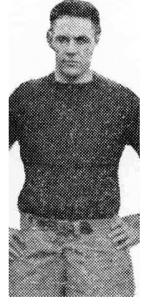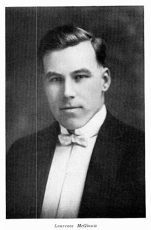 The opening of a new NFL season provides an opportunity for the Marquette family to remember that there was a time when Marquette University was a regular supplier of players to the National Football League. In the early 1920s, this could be said about the Marquette Law School as well as Marquette College.
The opening of a new NFL season provides an opportunity for the Marquette family to remember that there was a time when Marquette University was a regular supplier of players to the National Football League. In the early 1920s, this could be said about the Marquette Law School as well as Marquette College.
An earlier post described the career of Lavern “Lavvy” Dilweg, L ’27, who, after an All-American career at Marquette, played for the Milwaukee Badgers and Green Bay Packers in the National Football League. After his playing career ended, Dilweg became a prominent lawyer in Green Bay and also served as a United States Congressman during the Second World War.
In addition to Dilweg, at least two other former Marquette law students—Claude “Biff” Taugher and Laurence “Mac” McGinnis—played in the NFL in the 1920s. To this list could also be added the name of Paul Robeson, who studied informally at the law school while playing for the Milwaukee Badgers in 1922.
This article deals with the career of “Biff” Taugher, a war hero turned law student who played fullback for the Green Bay Packers during the 1922 season. A second post will deal with Taugher’s teammate, law school classmate, and fellow NFL alumnus, Laurence McGinnis.
Claude Buckley Taugher was born in 1895, in Marathon County, Wisconsin, the son of country doctor P.J. Taugher and Mary Buckley Taugher. Taugher attended high school in Wausau, and at age 21 enrolled at Carroll College in Waukesha, where he played varsity football.
In 1917, Taugher’s college career was interrupted by the United States’ entry in World War I. That year, he left Carroll College for the United States Marines, in which he was commissioned a second lieutenant.
Fighting in France in November 1918, as a member of the 6th Regiment of the Marine Corps’ 2nd Division, Taugher’s platoon successfully stormed the French village of Bayonville, capturing 61 German soldiers in the process. Although wounded in the battle, Taugher refused to leave his troops. For his “extraordinary heroism in action,” he was subsequently awarded both the Navy Cross and the Distinguished Service Cross. Nine days after the incident at Bayonville, the Armistice was signed, and Taugher was discharged from the Marines as a first lieutenant on August 15, 1919.
Returning to Wisconsin, Taugher enrolled at Marquette for the fall 1919 semester and immediately became part of the football team. Initially enrolling in the college, he entered the law school the following fall (1920) as a full-time day student.
Marquette was a regional power in college football in the late 1910s and 1920s, and during Taugher’s three years on the team, the Hilltoppers compiled records of 6-2-1, 6-1-0, and 6-2-1. Taugher’s first season with the team included both 20-0 and 31-0 trouncings of his former school, Carroll College, and a disappointing 13-0 loss to the University of Wisconsin. (The Marquette-UW “series” ended after the 1919 season and did not resume until 1932.)
Clearly, the most highly publicized game of Taugher’s career at Marquette was the November 19, 1921 match in Milwaukee between Marquette and Knute Rockne’s Fighting Irish of Notre Dame. In the post-World War I era, Notre Dame was universally recognized as the strongest team in college football—it went undefeated in 1919 and 1920, and from 1919 to 1924, it compiled an overall record of 55-4-0.
Undeterred, Marquette jumped out to an early 7-0 lead on a 4th down touchdown by Taugher that followed a blocked punt. Notre Dame scored to tie the game in the second period, but the game, described by the New York Times as “slowed considerably by a wet and muddy field,” remained deadlocked until the final period when the Marquette defense finally succumbed, allowing Notre Dame to hobble away with a 21-7 victory.
The Hilltoppers rebounded the following week with a 7-0 victory over Wabash in the season finale. Not counting the Notre Dame game, Marquette outscored its 1921 opponents by a total of 130 points to 8, while keeping all eight opponents from scoring a touchdown. (The 8 points came on two field goals and a safety.) Besides the Notre Dame loss, the only two “blemishes” on the team’s record were a 3-0 loss to Creighton and a 0-0 tie with Ripon.
His college eligibility exhausted, Taugher appears to have either withdrawn or been dismissed from the law school after the fall semester of 1921. In September 1922, he signed a contract with the Green Bay Packers, but only after assuring Packer player-coach Curly Lambeau that he had no remaining college eligibility.
Under the NFL’s own rules, teams were not permitted to sign players who still retained college eligibility. The Packers had been expelled from the NFL in January of 1922 because of the team’s use of still-eligible college players the previous season, and while they were subsequently reinstated with new ownership, Lambeau was particularly concerned that the team sign no more ineligible players.
At the time of his signing, which predated the NFL draft by more than a decade, Taugher was already well known to the Packers, and not just because of his success at Marquette. In 1920, following the conclusion of the Marquette season, Taugher had joined a team known as the Milwaukee All-Stars which scheduled a game against the Packers, then an independent professional team. (Green Bay would join the NFL, still known as the Professional Football Association of America, the following year.) Taugher had starred in the game, and two years later, his exploits in that game were still clearly remembered in Green Bay.
At the time he signed with the Packers, Taugher was 27 years old, and weighed in at 5’10” tall and 185 pounds. He would be one of seven former Marquette football players who would appear in games for the Packers during the 1922 season.
Unfortunately, Taugher’s stint with the Packers proved to be quite brief. Early in the season, he lost the battle for the starting fullback position to a 29-year-old rookie from Penn State named Stan Mills. As a Packer, Taugher played in only two games, one of which he started, and according to the Neft and Cohen Encyclopedia of Professional Football, in those two games he carried the ball only four times for a total of two yards. However, one of his carries did result in a touchdown.
With a roster limited by league rules to 18 players, the Packers apparently concluded that they did not have a spot for Taugher, and the 27-year-old fullback was cut loose. After starting the season 0-3-0, the Taugher-less Packers rebounded by winning four games and tying three in their final seven games.
Relatively little is known about the details of Taugher’s life after his departure from the Packers, but it appears that there were many bumps in the road in a life marked by deception, petty crime, and alcohol. In the summer of 1923, Taugher was appointed head football coach of Mount St. Charles College in Helena, Montana, and his impending arrival was celebrated by the Helena newspaper. Coincidentally, the Montana team, like Marquette in Taugher’s time, was nicknamed the “Hilltoppers.” However, a story in the Helena paper reported that in addition to being a football star, Taugher was also a graduate of Carroll College and the Marquette Law School. Neither assertion was correct, and one guesses that Taugher was the source of the misinformation.
However, by the time the 1923 season began Taugher was no longer the coach at the Montana school, and instead was engaged as head coach at his undergraduate alma mater, Carroll College of Waukesha, Wisconsin. Whether Taugher resigned the Montana position when the Carroll opening appeared or whether he was fired by his new employer is not known. (Somewhat ironically, Mount St. Charles College changed its name to Carroll College in 1932, and, still sporting that name, is today a leading small college football power.)
Alas, Taugher was no more successful as a college coach than he was as an NFL fullback. Carroll went winless in 1923, and after the end of the season, Taugher’s contract was not renewed.
Taugher appears to have led something of a vagabond existence, dividing his post-football life between the Fox Valley, Milwaukee, and Washington, D.C. He married Marguerite Heney in Green Bay in 1926, and the couple had four children, three of whom survived to adulthood. Although Taugher lived in different places in the 1930s and 1940s, his daughters all appear to have graduated from high school in Green Bay.
While his stay with the Packers had been brief, he was apparently recognized as a member of the Packer family, and in 1928, he participated in one of the first Packer homecoming games in Green Bay, although reports of his appearance mistakenly referred to him as a prominent physician in Milwaukee. In 1930, he was appointed to the position of Probation Officer in Milwaukee, but in 1935, he was convicted of the offense of drunk in public in Washington, D.C. A similarly embarrassing incident occurred in 1943, when he resided in Appleton.
Taugher died on February 8, 1963, and was buried Milwaukee’s Wood National Cemetery.
Years after his death, Claude Taugher also appeared as a character in Clarence J. Rockey’s 2006 novel, The Tin Tie, which is a fictional account of a young German soldier from World War I who emigrates to Milwaukee and enrolls at Marquette. The protagonist joins the Marquette football team where one of his teammates is Claude Taugher. Taugher graciously befriends the young “Kraut,” even though he quickly learns that he and his new teammate had only a year earlier been trying to kill each other on the battlefields of Europe.
 In recent years, Marquette has won numerous kudos for its program in legal research and writing. Although the current version of the program is still relatively new, the teaching of legal research and writing at Marquette has its roots in the 1920’s.
In recent years, Marquette has won numerous kudos for its program in legal research and writing. Although the current version of the program is still relatively new, the teaching of legal research and writing at Marquette has its roots in the 1920’s.
 Laurence J. McGinnis, usually known as “Larry” or “Mac,” was a football teammate and fellow Marquette law student of both
Laurence J. McGinnis, usually known as “Larry” or “Mac,” was a football teammate and fellow Marquette law student of both 